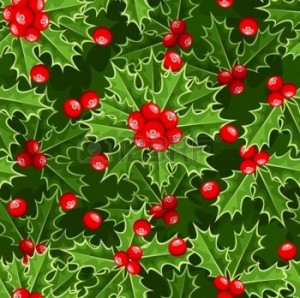 Holly (Ilex) and ivy (Hedera helix) have been used as winter decorations since ancient times. Adorning homes with these plants freshened the air and their greenery reminded occupants of the coming spring. The cold, dark days of winter turned much of the landscape dreary. However, many varieties of holly and ivy remained green year round, signifying eternal life. And the bright red berries of some holly plants were cheerful spots of color.
Holly (Ilex) and ivy (Hedera helix) have been used as winter decorations since ancient times. Adorning homes with these plants freshened the air and their greenery reminded occupants of the coming spring. The cold, dark days of winter turned much of the landscape dreary. However, many varieties of holly and ivy remained green year round, signifying eternal life. And the bright red berries of some holly plants were cheerful spots of color.
Additionally, holly trees and shrubs and the ornamental vine ivy were each believed to have magical properties. In many ancient cultures, the howling, icy winds in the dark nights of winter were believed to be ghosts and demons. Decorating with holly and ivy was thought to ward off these evil spirits.
Holly’s Use During Winter Festivals
Holly has long been associated with winter holidays. Early Europeans used holly as ornamentation during their winter solstice celebrations. The winter solstice, which occurs in late December in the northern hemisphere, was the longest night of the year and signified the gradual lengthening of days and coming spring — a cause for celebration. In Norse mythology, holly was associated with Thor, god of thunder, and holly plants grown by the home were thought to prevent lightning strikes. Ancient Romans used holly as 
decor during Saturnalia, a festival dedicated to Saturn, god of agriculture and husbandry.
Holly’s symbolism of the new season made it an appropriate and colorful ornament for winter festivities.
The use of ivy during winter also goes back thousands of years. The fact that ivy, like some hollies, stayed green throughout the year led some to believe it had magical properties. Consequently this led to its use as home decor in the winter months. It too, symbolized eternal life, rebirth and the spring season. In some cultures, ivy was a symbol of marriage and friendship, perhaps due to its tendency to cling. In ancient Rome, ivy was associated with Bacchus (known as Dionysus in Greek mythology), god of wine and revelry. Accordingly, it was sometimes used as trimming in ancient festivals. Though not as popular as holly, ivy was still used in festivals held during winter by many cultures.
Secrecy and Symbolism
Over time, many customs from pagan (non-Christian) celebrations were incorporated by Christians into religious holidays. For a period, ivy was banished as decor by Christians due to its ability to grow in shade, which led to its association with secrecy and debauchery. Nevertheless, the custom of decorating with holly and ivy during Christian holidays was eventually accepted. Religious meaning was later attributed to the physical  properties of holly, in particular. Its sharp leaves were said to symbolize Christ’s crown of thorns and its red berries the blood he shed.
properties of holly, in particular. Its sharp leaves were said to symbolize Christ’s crown of thorns and its red berries the blood he shed.
Today, holly and ivy are still used in our celebration of modern Christmas. They are often used in the creation of Christmas wreaths, boughs and other trimmings. While belief in their mystical powers may have dissipated, nonetheless they remain beautiful decorations for the holiday home.
From history of Holly and Ivy.
“The Holly and the Ivy” is one of the oldest Christmas carols still being sung today, dating back to the early 18th century.

The holly and the ivy brighten our homes in the dark days of winter, and the reminder of Christ’s love brightens our hearts.